

Search Challenge (11/11/15): Fake or real? How do you know? Unfortunately... ... people have been faking stories, photos, and claims for as long as humans have been around.
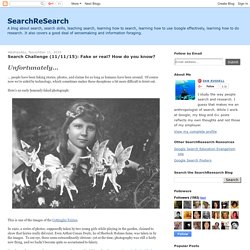
Of course now we're aided by technology, which sometimes makes these deceptions a bit more difficult to ferret out. Here's an early famously faked photograph: This is one of the images of the Cottingley Fairies. In 1920, a series of photos, supposedly taken by two young girls while playing in the garden, claimed to show that fairies really did exist. Even Arthur Conan Doyle, he of Sherlock Holmes fame, was taken in by the images. 2. Evaluating Websites as Information Sources. Studies suggest that many U.S. students are too trusting of information found on the internet and rarely evaluate the credibility of a website’s information.
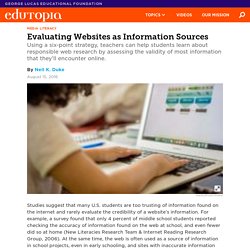
For example, a survey found that only 4 percent of middle school students reported checking the accuracy of information found on the web at school, and even fewer did so at home (New Literacies Research Team & Internet Reading Research Group, 2006). At the same time, the web is often used as a source of information in school projects, even in early schooling, and sites with inaccurate information can come up high in search rankings. Website Eval. Copy of CARS. TechieTeacher5280: Evaluating Websites. Each Friday, I spend time at the media center of a local high school making myself available to teachers who may need tech help.
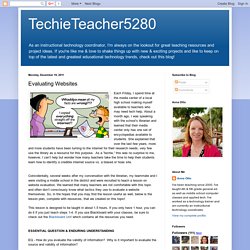
Boolify Lesson Plan: Evaluating Websites. Evaluating Web Sites: A Middle School Lesson Plan. Subjects Educational Technology Grade 6-8 [facebookbadge] Brief Description Students learn the six criteria for evaluating Web sites and then use those criteria to locate three sites that provide good information and three that do not.
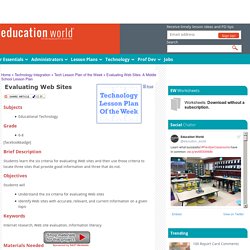
Objectives. Evaluating Web Sites: Criteria and Tools. Context ] ~ [ Evaluation Criteria ] ~ [ Online Selection ] ~ [ Webliography ] Context: The Primary Factor The User Context: The most important factor when evaluating Web sites is your search, your needs.
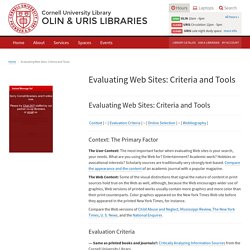
Module 2, Unit 2: Evaluating sources - Section index. Identify bias. It's important to understand bias when you are researching because it helps you see the purpose of a text, whether it's a piece of writing, a painting, a photograph - anything.

You need to be able to identify bias in every source you use. Who created the resource? Whether it's a book, journal article, website or photograph, sources are influenced by the ideas of the person who created them. The creator's age, religion, race and occupation. Q.U.I.C.K method for Evaluating Websites. Weighing it up Dr Susan Sandretto from Otago University gave a stunning keynote address at the recent SLANZA Conference in Wellington on Planning for Critical Literacy.
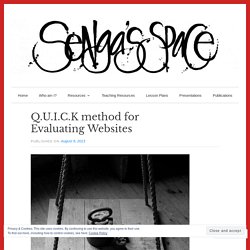
She is an engaging speaker and able to communicate well the need for us as teachers and librarians to create opportunities for teaching students about critical literacy and have them explore what it means to analyse text critically. I have been fortunate enough to hear Susan speak on two previous occasions and she has been pivotal in giving me the necessary skills to design these two lessons, which help students grasp this concept in a digital environment.
This is the poster I developed using information Susan gave in hand-out form at her workshop I attended about two years ago. I had several teaching colleagues also attend this workshop, and these posters were ultimately displayed in classrooms throughout the school. Lesson 1: How to Evaluate a Website – Q.U.I.C.K Lesson 2: Evaluating Websites. The Quality Information Checklist. This page is printable.
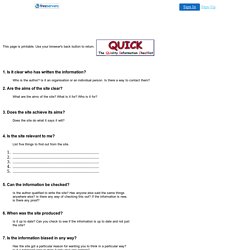
Use your browser's back button to return. 1. Evaluating internet information. Information comes to us from a wide variety of sources.

3-5 Search Lesson Plan. Web site evaluation - Google Slides. 1135 hoax. 3-5 Search Lesson Plan. Hoax or No Hoax? Strategies for Online Comprehension and Evaluation. Excellent Checklist for Evaluating Information Sources. April 8, 2014 Digital literacy, as a set of skills that students need to develop and master in order to properly use digital technologies , is an essential component of the 21st century education.
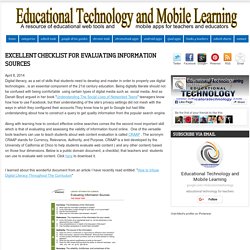
Being digitally literate should not be confused with being comfortable using certain types of digital media such as social media. And as Danah Boyd argued in her book "Understanding The Social Lives of Networked Teens" teenagers know how how to use Facebook, but their understanding of the site’s privacy settings did not mesh with the ways in which they configured their accounts.They know how to get to Google but had little understanding about how to construct a query to get quality information from the popular search engine. Along with learning how to conduct effective online searches comes the the second most important skill which is that of evaluating and assessing the validity of information found online.
Critical Evaluation. Website Evaluation Presentation. Evaluating Websites for the Elementary Student: created with Zunal WebQuest Maker. Activity 1: Below you will find 3 questions, each accompanied by a pair of websites. For each pair, one website is "Real" and one is a "Hoax". Complete an Evaluation Checklist (created in Activity 2 of STEP 3) for each website and use it to help you determine which is which. Notice that when you figure out which site is "Real" you will also have figured out the answer to the question. Be sure to complete the Justification Section of the Evaluation Checklist for each website. Critical Appraisal and Analysis - Critically Analyzing Information Sources. A. Author What are the author's credentials--institutional affiliation (where he or she works), educational background, past writings, or experience?
Is the book or article written on a topic in the author's area of expertise? You can use the various Who's Who publications for the U.S. and other countries and for specific subjects and the biographical information located in the publication itself to help determine the author's affiliation and credentials.Has your instructor mentioned this author? Have you seen the author's name cited in other sources or bibliographies?
B. When was the source published? C.